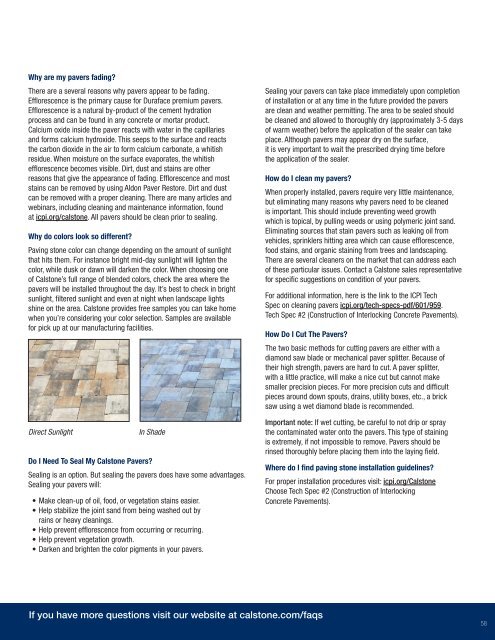Calstone Catalog
Calstone's Hardscape Collection: Paving Stones, Landscape Structures and Retaining Walls.
Calstone's Hardscape Collection: Paving Stones, Landscape Structures and Retaining Walls.
You also want an ePaper? Increase the reach of your titles
YUMPU automatically turns print PDFs into web optimized ePapers that Google loves.
Why are my pavers fading?<br />
There are a several reasons why pavers appear to be fading.<br />
Efflorescence is the primary cause for Duraface premium pavers.<br />
Efflorescence is a natural by-product of the cement hydration<br />
process and can be found in any concrete or mortar product.<br />
Calcium oxide inside the paver reacts with water in the capillaries<br />
and forms calcium hydroxide. This seeps to the surface and reacts<br />
the carbon dioxide in the air to form calcium carbonate, a whitish<br />
residue. When moisture on the surface evaporates, the whitish<br />
efflorescence becomes visible. Dirt, dust and stains are other<br />
reasons that give the appearance of fading. Efflorescence and most<br />
stains can be removed by using Aldon Paver Restore. Dirt and dust<br />
can be removed with a proper cleaning. There are many articles and<br />
webinars, including cleaning and maintenance information, found<br />
at icpi.org/calstone. All pavers should be clean prior to sealing.<br />
Why do colors look so different?<br />
Paving stone color can change depending on the amount of sunlight<br />
that hits them. For instance bright mid-day sunlight will lighten the<br />
color, while dusk or dawn will darken the color. When choosing one<br />
of <strong>Calstone</strong>’s full range of blended colors, check the area where the<br />
pavers will be installed throughout the day. It’s best to check in bright<br />
sunlight, filtered sunlight and even at night when landscape lights<br />
shine on the area. <strong>Calstone</strong> provides free samples you can take home<br />
when you’re considering your color selection. Samples are available<br />
for pick up at our manufacturing facilities.<br />
Direct Sunlight<br />
In Shade<br />
Do I Need To Seal My <strong>Calstone</strong> Pavers?<br />
Sealing is an option. But sealing the pavers does have some advantages.<br />
Sealing your pavers will:<br />
• Make clean-up of oil, food, or vegetation stains easier.<br />
• Help stabilize the joint sand from being washed out by<br />
rains or heavy cleanings.<br />
• Help prevent efflorescence from occurring or recurring.<br />
• Help prevent vegetation growth.<br />
• Darken and brighten the color pigments in your pavers.<br />
Sealing your pavers can take place immediately upon completion<br />
of installation or at any time in the future provided the pavers<br />
are clean and weather permitting. The area to be sealed should<br />
be cleaned and allowed to thoroughly dry (approximately 3-5 days<br />
of warm weather) before the application of the sealer can take<br />
place. Although pavers may appear dry on the surface,<br />
it is very important to wait the prescribed drying time before<br />
the application of the sealer.<br />
How do I clean my pavers?<br />
When properly installed, pavers require very little maintenance,<br />
but eliminating many reasons why pavers need to be cleaned<br />
is important. This should include preventing weed growth<br />
which is topical, by pulling weeds or using polymeric joint sand.<br />
Eliminating sources that stain pavers such as leaking oil from<br />
vehicles, sprinklers hitting area which can cause efflorescence,<br />
food stains, and organic staining from trees and landscaping.<br />
There are several cleaners on the market that can address each<br />
of these particular issues. Contact a <strong>Calstone</strong> sales representative<br />
for specific suggestions on condition of your pavers.<br />
For additional information, here is the link to the ICPI Tech<br />
Spec on cleaning pavers icpi.org/tech-specs-pdf/601/959.<br />
Tech Spec #2 (Construction of Interlocking Concrete Pavements).<br />
How Do I Cut The Pavers?<br />
The two basic methods for cutting pavers are either with a<br />
diamond saw blade or mechanical paver splitter. Because of<br />
their high strength, pavers are hard to cut. A paver splitter,<br />
with a little practice, will make a nice cut but cannot make<br />
smaller precision pieces. For more precision cuts and difficult<br />
pieces around down spouts, drains, utility boxes, etc., a brick<br />
saw using a wet diamond blade is recommended.<br />
Important note: If wet cutting, be careful to not drip or spray<br />
the contaminated water onto the pavers. This type of staining<br />
is extremely, if not impossible to remove. Pavers should be<br />
rinsed thoroughly before placing them into the laying field.<br />
Where do I find paving stone installation guidelines?<br />
For proper installation procedures visit: icpi.org/<strong>Calstone</strong><br />
Choose Tech Spec #2 (Construction of Interlocking<br />
Concrete Pavements).<br />
If you have more questions visit our website at calstone.com/faqs<br />
58




